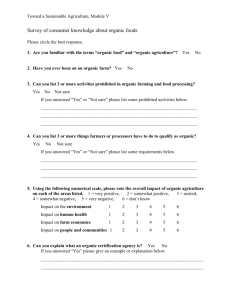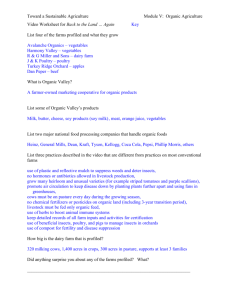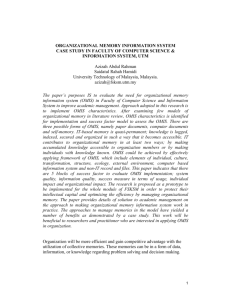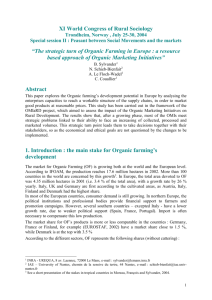The future policy environment of organic farming and its impact on
advertisement
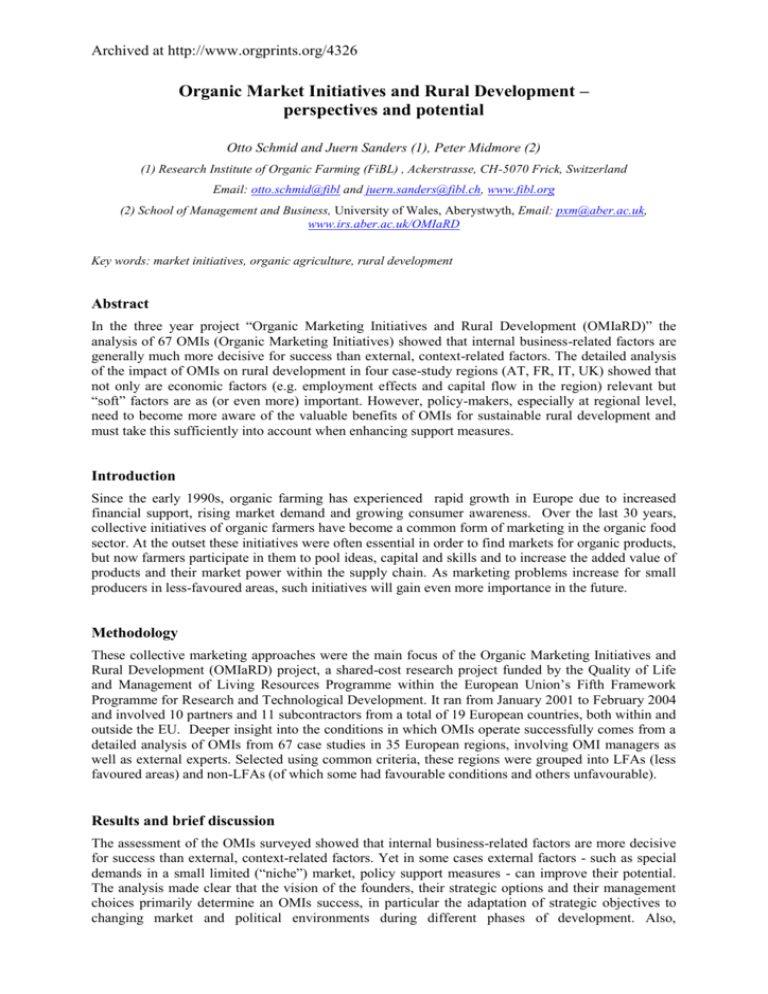
Archived at http://www.orgprints.org/4326 Organic Market Initiatives and Rural Development – perspectives and potential Otto Schmid and Juern Sanders (1), Peter Midmore (2) (1) Research Institute of Organic Farming (FiBL) , Ackerstrasse, CH-5070 Frick, Switzerland Email: otto.schmid@fibl and juern.sanders@fibl.ch, www.fibl.org (2) School of Management and Business, University of Wales, Aberystwyth, Email: pxm@aber.ac.uk, www.irs.aber.ac.uk/OMIaRD Key words: market initiatives, organic agriculture, rural development Abstract In the three year project “Organic Marketing Initiatives and Rural Development (OMIaRD)” the analysis of 67 OMIs (Organic Marketing Initiatives) showed that internal business-related factors are generally much more decisive for success than external, context-related factors. The detailed analysis of the impact of OMIs on rural development in four case-study regions (AT, FR, IT, UK) showed that not only are economic factors (e.g. employment effects and capital flow in the region) relevant but “soft” factors are as (or even more) important. However, policy-makers, especially at regional level, need to become more aware of the valuable benefits of OMIs for sustainable rural development and must take this sufficiently into account when enhancing support measures. Introduction Since the early 1990s, organic farming has experienced rapid growth in Europe due to increased financial support, rising market demand and growing consumer awareness. Over the last 30 years, collective initiatives of organic farmers have become a common form of marketing in the organic food sector. At the outset these initiatives were often essential in order to find markets for organic products, but now farmers participate in them to pool ideas, capital and skills and to increase the added value of products and their market power within the supply chain. As marketing problems increase for small producers in less-favoured areas, such initiatives will gain even more importance in the future. Methodology These collective marketing approaches were the main focus of the Organic Marketing Initiatives and Rural Development (OMIaRD) project, a shared-cost research project funded by the Quality of Life and Management of Living Resources Programme within the European Union’s Fifth Framework Programme for Research and Technological Development. It ran from January 2001 to February 2004 and involved 10 partners and 11 subcontractors from a total of 19 European countries, both within and outside the EU. Deeper insight into the conditions in which OMIs operate successfully comes from a detailed analysis of OMIs from 67 case studies in 35 European regions, involving OMI managers as well as external experts. Selected using common criteria, these regions were grouped into LFAs (less favoured areas) and non-LFAs (of which some had favourable conditions and others unfavourable). Results and brief discussion The assessment of the OMIs surveyed showed that internal business-related factors are more decisive for success than external, context-related factors. Yet in some cases external factors - such as special demands in a small limited (“niche”) market, policy support measures - can improve their potential. The analysis made clear that the vision of the founders, their strategic options and their management choices primarily determine an OMIs success, in particular the adaptation of strategic objectives to changing market and political environments during different phases of development. Also, Archived at http://www.orgprints.org/4326 maintaining the motivation of members and other internal and external cohesion factors are major challenges to achieving not only economic but also wider social, environmental and political goals (Fig. 1). Figure 1. Internal and external success factors Public Funding and Support Key Persons Economies of Scale Market Research Brands and Brand Ownership Potential of Networking Internal Success Factors Clear Objectives and Strategic Planning Motivation, Competence Innovation Regional Context Market Environment Professional Management Acceptance of Strategic Turning Points External Success Factors A basic assumption of the analysis is that the choice of different objectives has a crucial impact on the OMI’s strategies and consequently on their successful development. It became apparent that OMIs aiming for social or environmental objectives tend to underestimate financial needs. In particular, such OMIs lack competency in financial management, in contrast to those with clear economic objectives. On the other hand, OMIs focusing mainly on economic objectives tend to neglect both human relations and regional networking. One of the key challenges is how the OMIs operate in different life cycle phases: the right decision on a strategic level as well as on the operational level might be quite different at different phases of the initiative’s development. Detailed analysis of the impact of OMIs on rural development in four case-study regions, using qualitative interviews with 15-20 different actors and stakeholders in the regions, showed that not only economic factors but also “soft” factors are relevant. The OMIs in all case studies (two pasta projects in Italy, a vegetable box scheme in the UK, a dairy in Austria and a meat initiative in France) achieve their social and environmental (and sometimes also political) objectives effectively, though on a rather small scale, for example by enhancing the status of farming, preventing abandonment of the countryside and improving the image of the region. However, policy-makers, especially at the regional level, need to become more aware of the valuable indirect benefits of OMIs for sustainable rural development and take this sufficiently into account when designing and enhancing support measures. Although OMIs have considerable potential to contribute to sustainable rural development, this is far from being realised. A range of approaches can help OMIs both to prosper and to increase their contribution to achieving such general aims. The policy framework can facilitate development and expansion of the producer-led marketing of organic products in order to achieve integration and additional benefit. CAP reforms in 2003 provide new resources for Rural Development Plans of member states, allowing them to support quality enhancement by groups of farmers (specifically identifying organic farming as eligible). However, financial support for joint action by farmers to improve quality in marketing and processing of their products is a necessary, but certainly not a sufficient; condition for OMIs to perform successfully. Policy support for the development of OMIs is limited to actions that remove barriers to development, or improve the conditions in which they operate. For consistent and sustained development, the ideas and effort must come from organic producers themselves and the communities in which they are embedded. However, success is seen in more general terms as combining effectiveness (formulating and achieving strategic objectives in line with initiators’ expectations) and efficiency (achieving objectives Archived at http://www.orgprints.org/4326 while maximising output or minimising costs). This relates to the capacity of OMIs to set and achieve relevant economic, social and environmental objectives, and to manage internal resources in a manner which minimises costs for a given output (or maximises output for a given cost), taking into account changing market and policy conditions. Conclusions A range of factors should be considered by policy-makers as well as OMI managers when formulating strategies to exploit potential more effectively and overcome limitations: considering market potentials and limitations; retaining and strengthening the ethical basis when growing; dealing with increased competition; reducing supermarket dependency through diversification; deciding for or against export; responding to the growing demand of convenience food; improving the price / cost relation. Other key factors to take into account are communication policy and supply policy with regard to product quality management. Some simple options OMIs should consider include: improved decision-making processes and management skills; realistic finance policies; cooperation with conventional agriculture and other supply chains as well as with organic food and farming organisations; improved vertical networking along supply chains; and horizontal networking in regions. The recommended policy support measures are: improved market transparency; support for knowledge transfer and advice; financial support for OMIs and organic farmers; consumer information and education; more public procurement of organic products; facilitation of cooperation and networking; research and development projects (Fig. 2). Table 1 outlines possible support measures (Schmid, et al., 2004). Figure 2. Appropriate policy support measures for OMIs Generate employment in the region Generate capital flow in the region Keep farmers and OMIs in business Improvement of Market transparency Payments for organic farmers Knowledge transfer and advice Raise self awareness Support for consumer information Multiply economic activities Financial support in start phase Public procurement of organic products Research and development projects Improve regional image/identity Contribute to healthy environment Stimulate innovations Link with local consumers To conclude, several OMIs, by improving their business activities and the environment in which they operate, can go further to achieve social and ecological goals and become a model for sustainable rural development. For both market-related and rural development-related activities, there is interesting and challenging potential for development and this can present real opportunities for OMIs. References Midmore, P., Foster, C. Schermer, M. (2004) Organic Producer Initiatives and Rural Development – four European Case Studies. OMIaRD Vol. 3, University of Wales, Aberystwyth. 217 p. Schmid, O., Richter, T., Hamm U., Dahlke, A. (2004) A Guide to Successful Marketing of Organic Food in Rural Areas. OMIaRD Vol. 6, Research Institute of Organic Agriculture, Frick. 204 p. (English and German) Schmid, O., Sanders, J., Midmore P. (2004) Organic Market Initiatives and Rural Development. Integrated Report. OMIaRD Vol. 7, University of Wales, Aberystwyth. 225 p. Sylvander, S., Kristensen, N. H: (2004): Organic Marketing Initiatives in Europe. OMIaRD Vol. 2, University of Wales, Aberystwyth. 225 p. Archived at http://www.orgprints.org/4326 Table 1 Suggested support measures Supporting Knowledge building among OMI and training measures for managers: exchange knowledge programmes and visits to increase awareness of national/international benchmarks. transfer/ Facilitate the development of an entrepreneurial culture, e.g. co-finance coaching advice activities, sending trainers around the various OMIs. Funding initial business consultancy services to ensure that support is based on sound analysis of market opportunities. Agricultural schools training on: business management skills, organic food marketing. Vocational training for farmers, especially for OMIs with networking facilities. Facilitating Public funding: encourage and facilitate OMIs to build up vertical alliances/cooperation cooperation along the food chain. Regional development agencies and consultancy services: assist OMIs and producer and networking organisations in networking in the region and along the food chain. Support via regional policy: assure coexistence of organic and GMO farming. Regional territorial approaches to organic agriculture: integrated into national organic action plans (e.g. as in United Kingdom and Spain). Support for More consumer information: confusion concerning organic and non-organic products. consumer Consumer education campaigns: appropriate information material, farm visits, events information Transmit to the consumer the intrinsic/added value of the OMIs’ products and the ethical dimensions of organic farming. Schools: raise awareness/enjoyment of organic food and the rural development dimension of organic farming. Support for good school programmes on farms Promote local organic products using regional logos/labels or support for local projects. Research Targeted support for research projects: e.g. for small-scale processing, developing high and quality organic food. develop Establish trans-national network of producer initiatives that market organically produced ment primary products: “organic food and farming observatory” to coordinate efforts. Procure Public procurement of OMI products: increase public awareness, open new sales channel ment of for OMIs. organic Developing organic catering in public and private schools products Limiting transport miles/distances by means of taxes: encouraging local sourcing. Financial Clear objectives and clear criteria (e.g. multiplier effects, degree of innovation, selfsupport financing capacities). mainly in Condition: appropriate business plan and a networking plan start phase (ensuring active involvement of stakeholders / regional actors). Different support: research and development, marketing communication measures, networking, risk management and investment. Generally be limited to the start-up phase. Use tax and VAT reduction strategies and Eco-taxes to promote organic food. Less bureaucracy:–I Introduce a “fast-track” (efficient and quick) support policy for OMIs: motivating and not de-motivating! Harmonise standards without being over-prescriptive: account for regional variation Improving Improving the regulatory framework: increase trace-ability, create more transparency (at market national and even more at trans-national level). transpar Clearer regulatory framework on labelling: make OMI products more visible. ency Market transparency: enhanced by consistent and stable statistical systems over the whole food chain (international, European and national level). Inspection and certification: facilitate more risk-based systems because of the small size of OMIs (reduced workload and lower costs). Financial Organic farming support schemes: coordinated with a long-term perspective, better incentives balanced between supply and demand. for organic Compensate “real” public good and services of farmers: e.g. payments for landscape and farmers biodiversity measures, high animal welfare, etc.






